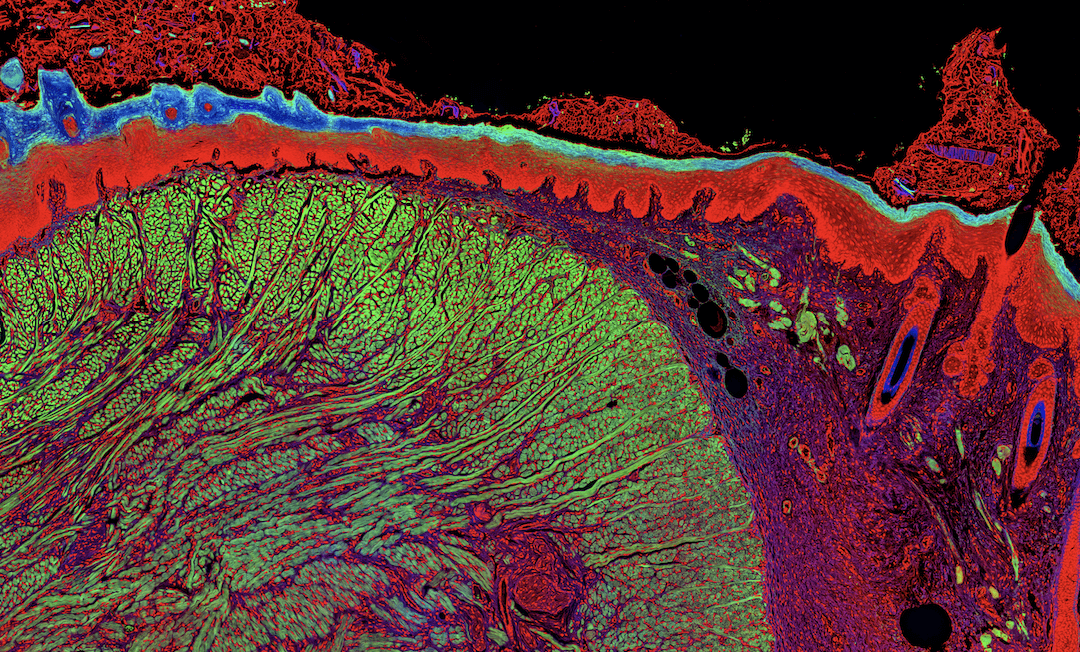Choosing the right fluorophores is critical for reliable results
Fluorescent detection offers significant advantages, including multiplexing capability, superior sensitivity, and a broader dynamic linear range compared to other detection methods. However, the unique characteristics of fluorophores can present challenges for experimental design. Understanding how key fluorophore properties align with your chosen model system is essential when selecting the right reagents for your research.
Fluorophore Properties
Fluorophores absorb light within a distinct range of wavelengths (the excitation spectrum) and emit light within another, longer range of wavelengths (the emission spectrum). The absorption maximum and emission maximum, which correspond to the peaks of these spectra, are key fluorophore properties to consider during experimental design. These values must align with the lasers and detectors of your instrument, and each fluorophore should have a different emission spectrum from other fluorophores in your experiment to ensure accurate identification of target analytes.
“When multiplexing, using fluorophores with narrow emission spectra will help to prevent bleed-through, which is where one fluorophore is detected in the channel of another,” comments Jarad Wilson, Ph.D., Associate Director at RayBiotech Life, Inc. The breadth of a fluorophore’s emission spectrum and the associated risk of bleed-through can be easily assessed with a Spectra Viewer.
The Stokes shift, the difference between the excitation and emission maxima, is another important fluorophore property to consider “If you plan to perform multiplexed detection, but you have only a limited number of lasers, selecting fluorophores with similar excitation maxima but different Stokes shifts is a popular way of increasing panel size,” reports Leslie Bibb, Technical Services Manager at SouthernBiotech. “Tandem dyes can be especially useful here as they achieve a higher Stokes shift through the process of Förster resonance energy transfer (FRET) to increase flexibility for panel design.”
Fluorophore brightness is also fundamental. This value is determined by the extinction coefficient (ε), which measures the fluorophore’s capacity to absorb light at a given wavelength in units of M−1cm−1, and the quantum yield (Φ), defined as the number of photons emitted per absorbed photon, ranging from a value of 0 – 1. Higher values for both coefficients indicate greater brightness. “As a general rule, it is recommended to pair bright fluorophores with low abundance targets and dim fluorophores with highly expressed proteins,” notes Wilson “This will maximize your chances of detecting targets with differential expression in the same experiment.”
Other fluorophore properties to take into consideration are pH sensitivity, which will influence your choice of assay diluent, and resistance to photobleaching, relevant to experiments with prolonged or repeated exposures.
Tips for Fluorophore Selection
In addition to our previous suggestions, there are other ways to ensure you are selecting appropriate fluorophores for your research. Here are our top five tips:
-
Understand your target of interest
In addition to understanding the expected abundance of your target of interest, it is important to consider its location. This is particularly relevant when using techniques like flow cytometry or immunocytochemistry for multiplexed detection of both extracellular and intracellular markers. “While staining for cell surface markers is usually straightforward, detecting intracellular targets requires that samples be fixed and permeabilized,” explains Bibb. “Fixation and permeabilization risk damaging extracellular epitopes, which can prevent antibody binding, so you may need to think about staining for extracellular markers first, before proceeding with intracellular target detection.”
-
Assign fluorophores to lesser known targets first
When it comes to selecting fluorophore-labeled antibodies for detecting lesser-known or newly discovered antigens, researchers often have fewer options compared to well-known targets. “In this situation, it can be sensible to assign fluorophores to rarer targets first,” suggests Wilson. “That way, there is more room for maneuver when it comes to designing the rest of the panel.”
-
Choose fluorophores distinct from your counterstain
Most immunofluorescent staining protocols use a counterstain to provide context for analyte-specific staining. The most widely used counterstains, DAPI, Hoechst 33342, and propidium iodide, are used for detecting nuclei. “When choosing a counterstain, it is imperative that it fits with the fluorophores being used for target detection,” says Bibb. “For example, if you are using an analyte-specific antibody labeled with a blue fluorophore such as Alexa Fluor® 405, DAPI would be incompatible as it also emits blue fluorescence. Propidium iodide, which emits in the red spectrum, would instead be a better choice.”
-
Factor in autofluorescence
Autofluorescence describes the inherent background signal in samples from naturally fluorescent biomolecules such as collagen, reduced NADH, and heme groups of red blood cells. “To evaluate autofluorescence in your chosen sample type, it is recommended to run an unlabeled / cells alone control,” says Bibb. “This will enable you to select fluorophores that are spectrally distinct from the observed autofluorescence.”
-
Consider using modern fluorophores to address common challenges
While fluorophores such as phycoerythrin (PE), allophycocyanin (APC), and fluorescein have been used for decades, newer products with increased brightness, narrower excitation and emission spectra, better photostability, and enhanced compatibility with staining buffers are now available. “Our RayBright® dyes have superior brightness to many fluorophores with equivalent emission maxima,” explains Wilson. “They also extend into the violet detection channel, for which it has historically been difficult to find labeled antibody reagents.”
Supporting Your Research
FluoroFinder has developed a suite of resources to help with reagent selection and experimental design. Compare the spectral properties of over 1,000 fluorophores in the context of your specific instrument configurations with our Spectra Viewer for microscopy and spectral and conventional flow cytometry.
Sign-up for our eNewsletter to read more about fluorophore selection and receive updates on a broad range of research techniques.





